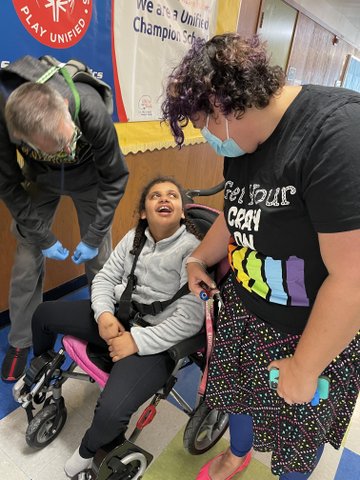
07 Oct Parents Learn Tools to Advocate for Disability Rights in the School System

Leanne Wu, right, a special education teacher at Tara Hills Elementary in San Pablo, with a student in 2021. (Courtesy of Leanne Wu / CC Pulse file)
By Aina de Lapparent Alvarez
Students with disabilities have the right to schooling that is free and appropriate to their needs — just like nondisabled students. But parents advocating for their children’s rights is key to upholding them.
On Thursday, the Parental African American Achievement Collaborative Team, which works to empower Black families in Pittsburg, and Disability Rights of California hosted a Zoom workshop for parents to learn about laws and procedures and what to do when school’s obligations go unmet.
>>>Read: Disadvantaged Students Are Especially Struggling Amid Teacher Shortages<<<
DRC attorney Maria Iriate and advocate Mary Rios also provided advice to keep on top of the bureaucracy: Write down everything.
“You want to keep copies of everything you submit to the school,” Rios said. “You never know when you’re going to need that.”
Disabled students have not always been given a place in education. The 1970s laid the groundwork for legal protections through Section 504 of the Rehabilitation Act and the Education for All Handicapped Children Act, known as the EHA for short. Before that, “many states had laws excluding certain students, including children who were deaf, blind, emotionally disturbed, or had an intellectual disability,” according to the U.S. Department of Education.
In the 1990s, the EHA changed its name to Individuals with Disabilities Education Act and required parental concern as a key aspect of children’s accommodations.
Accommodations in Education: IEPs and 504s
By law, all schools have to identify and evaluate children with disabilities up to 21 years old. That includes public and private schools as well as foster care.
Many types of disability and impairment can qualify a child for accommodations in education. To ensure the school meets the child’s needs, the school and the parent draft a plan. If a child needs the support of educational services with specially designed instruction, that document is called an individualized education plan. To qualify for an IEP, the child’s disability has to adversely impact their educational performance.
>>>From Our Archives:
‘We Can Reimagine How We Teach’: How Four WCCUSD Teachers Adapted to Distance Learning<<<
Otherwise, the student may qualify for a 504 plan, which takes place within a general education setting and has less protections than the IEP. A 504 doesn’t have to be a written document or track annual goals.
For an IEP, the process starts with a referral by the school or the parents. Within 15 days, the school has to appoint who will assess the child.
Parents have to sign on the assessment plan and can include comments, Rios said.
“You may want to write under the comment section: Please provide copies of the assessment reports at least five days before the IEP meeting,” she said.
Then, the school has 60 days to do the assessment and hold the IEP meeting.
Parents also sign on the assessment and can request an independent assessment.
‘If It’s Not Documented in the IEP, It Doesn’t Exist’
The meeting’s date must be mutually agreed. Parents have the right to an interpreter and to record the meeting if they notify the district 24 hours in advance.
Rios said it is important to include the child. “Make a list of what you and your child would like to happen for that particular school year,” she said.
It is also useful to review last year’s IEP, the assessment made, and any material received during the year like report cards, progress reports, disciplinary records and the like.
IEP team members can include the special education teacher, the general education teacher, a school district representative who is knowledgeable, a service provider, the person who did the assessment. A friend or advocate of the parent could also be present.
An IEP is thorough legal document; it can include:
- Eligibility
- Present level of performance
- Goals and objectives
- Related services
- Accommodations and modifications
- Behavioral plan
- Classroom plan
- Team member notes
- An individualized transition plan to work on what the child will do after graduating, if the student is 16 or older.
Parents have the right to meaningful participation through questions and submitting agenda items. Without their consent, the IEP can’t be implemented.
Consent can be full, partial or not given at all.
“Never sign at the IEP meeting,” Rios said. “Take the IEP, the IEP document, home, review it; make sure that everything that you spoke about in terms of support and services are documented in the IEP. Remember, if it’s not documented in the IEP, it doesn’t exist.”
That meeting must be held annually. Concerned parents can request an additional or earlier meeting. The school has a 30-day deadline to make it happen.
Every three years, the school reassesses the students to check what accommodations are needed.
‘If You Don’t Complain, Nothing Will Change’
If the district isn’t complying, parents have recourse both at the state and the federal level.
The California Department of Education accepts complaints within one year of the incident. The department has then 60 days to investigate.
The Office of Civil Rights of the U.S. Department of Education can also be a venue. But complaints must be filed within 180 days of the incident and the department doesn’t have a timeline to investigate.
There are also mediation venues to engage with the district, but the clock is still ticking for the complaints.
“Today, you learned some tools,” Iriarte said. “These are things you need to be doing. If you don’t complain, nothing will change.”
For more information, read the DRC’s Special Education Rights and Responsibilities Manual.






No Comments